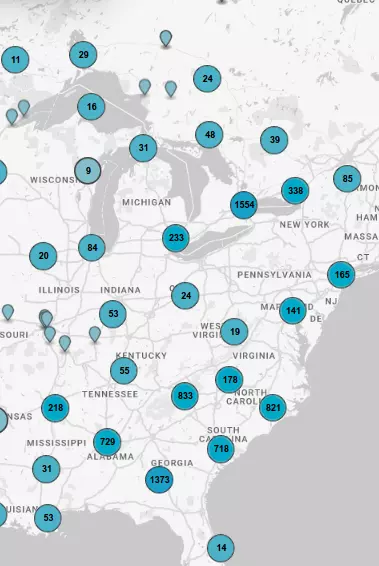Price Memorial Building
Erected here in 1837 was a U.S. Branch Mint which operated until seized by the Confederates in 1861. It produced gold coins estimated to exceed $6,000,000.00 in value. In 1871 the mint...
- lat34
Dahlonega Mustering Grounds
During the War Between the States nine companies were organized on this site: five were mustered here in 1861, two in 1862 and two in 1864. Men from other North Georgia counties came to Dahlonega...
- lat34
Gold Diggers' Road
This section of highway was once a part of the "Gold Diggers´ Road". One of the earliest ways used to reach this area during the Gold Rush days. Beginning on the Chestatee River to the east, where...
- lat34
The Station
This is the site of one the forts or stations used by the United States round up the Cherokee Indians for their removal to western reservations. General Winfield Scott, commander of the troops...
- lat34
Auraria
Auraria, (Gold), in 1832 the scene of Georgia´s first gold rush, was named by John C. Calhoun owner of a nearby mine worked by Calhoun slaves. Auraria and Dahlonega were the two real gold towns in...
- lat34
Consolidated Gold Mines
One mile southeast of here, from 1900 to 1906, the Dahlonega Consolidated Mining Company operated what is considered the largest gold plant ever constructed east of the Mississippi...
- lat34
Trahlyta's Grave
This pile of stones marks the grave of a Cherokee princess, Trahlyta. According to legend her tribe, living on Cedar Mountain north of here, knew the secret of the magic springs of eternal youth...
- lat34
Findley Ridge
Many famous gold mines of the Dahlonega era were along this ridge on both sides of this highway. The saprolite and vein gold mining operation along here contributed much to the $35,000,000 in...
- lat34
Calhoun Gold Mine
Famous Calhoun Gold Mine where it is said vein gold was first discovered in Georgia by white men. In 1828 while deer hunting Benjamin Parks, of Dahlonega, accidentally found quartz gold in pockets...
- lat34
Drexel Park
In 1916 five prominent Valdosta businessmen and civic leaders--William S. West, Lowndes W. Shaw, Leonard F. Shaw, Daniel C. Ashley, and Owen K. Jones--donated 11 acres to the city to create...
- lat34
Blue Star Memorial Highway
A tribute to the Armed Forces that have defended the United States of America The Garden Club of Georgia, Inc Department of Transportation of Georgia The Garden Center and Valdosta Garden Clubs...
- lat34
Primitive Baptist Church
Built in 1869 by the Valdosta Baptist Church, this is the oldest extant Church building in Valdosta. The building was purchased by the Valdosta Primitive Baptist Church when it was constituted on...
- lat34
Christian Science Church
The Valdosta Episcopal Congregation, organized ca. 1871, held services in the courthouse until this building, originally a frame structure, was constructed in 1885. (Stucco was added in 1910.) The...
- lat34
Troupville
The site Troupville the first town and stage coach line in Lowndes County settled 1836. This marker erected by Valdosta Chapter U.D.C. 471 April 26th, 1927. Plaque courtesy Lat34North.com....
- lat34
First Presbyterian Church
Organized by Settlers from Liberty County on Dec 3, 1864. The first minister, Rev Eli Graves, came from Brooks County once a month to hold services in the courthouse before the first church...
- lat34
Old City Hall
Site of the Old City Hall at Ashley St. and Hill Ave. The City Hall, a brick and granite two-story structure built in 1895, was "the ornament of the town" with its 70-ft. Clock Tower. For 63 years...
- lat34
Nations Bank
A private owned bank was founded in 1874 in Valdosta by Remery. Lane as the R. Y. Lane banking Co. In 1888 Lane, with others, formed the Merchants Bank which evolved into the Citizens and Southern...
- lat34
Valdosta Institute
S. M. Varnedoe was administrator of a ten-grade private school. The Valdosta Institute, 1885 - 70. Famous among its students was J. H. "Doc" Holiday. The Masong and several churches also used...
- lat34
Site of Cotton Exchange
This corner, Wall Street and West Hill Ave., was the site of the largest inland Sea Island Cotton Market in the world in 1910. Because of this cotton market, Valdosta was named the center...
- lat34
Valdosta Street Railroad Company Waiting Station, 1917
The waiting station erected for the ladies at South Ga. State Normal College (in 1950, Valdosta State College), is all that remains of the streetcar system. The electric railroad was begun in 1899...
- lat34
